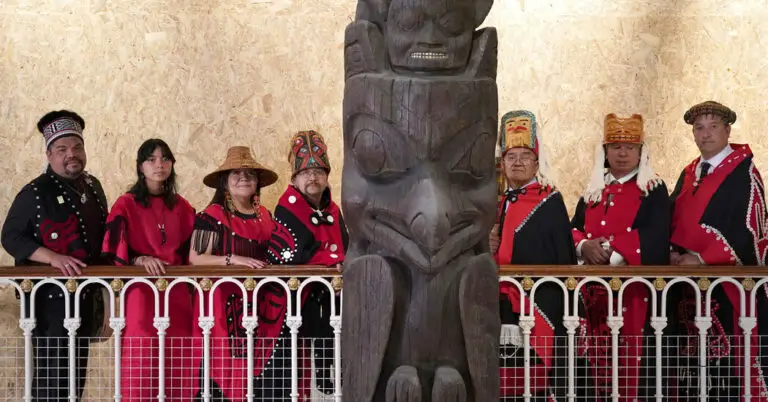Totem Pole Honoring Warrior Returns Home After Almost a Century
Almost a century ago, a towering totem pole was cut down in Canada’s British Columbia. This 36-foot red cedar creation was carved in the 1860s to honor Ts’wawit, a warrior from the Indigenous Nisga’a Nation, who was destined to be chief before meeting his end in conflict.
Back in 1929, Canadian anthropologist Marius Barbeau orchestrated the totem pole’s removal while the Nisga’a people were away for their yearly hunting and fishing expedition. He shipped it over 4,000 miles to the Royal Scottish Museum, now known as the National Museum of Scotland, in Edinburgh.
Finally, after decades of effort by the Nisga’a Nation, the memorial totem pole is on its way back home. A Nisga’a delegation, dressed in traditional red and black robes, conducted a spiritual ceremony at the museum to prepare the pole for its journey back to Canada.
The Nisg̱a’a hold a belief that the totem pole holds a spirit within it and regard it as a living being, rather than a mere object. Dr. Amy Parent, an associate professor at Simon Fraser University, emphasized that the pole is like a family member imprisoned in a museum. The pole serves as a profound connection to their history.
This event marks one of the initial repatriations of items from British national institutions. Despite global movements for artifact return, Britain has been reluctant. The National Museum of Scotland, however, operates under a different statute that permits the return of artifacts in certain circumstances.
The museum recently determined that Marius Barbeau had acquired the pole unethically during a time of unjust actions towards First Nations people. This discovery has prompted the Scottish government to partially fund the pole’s journey back to the Nisga’a museum in Nass Valley.
Remarkably, the Nisga’a delegation used the term “rematriation” instead of “repatriation” to mirror their matrilineal structure.
The National Museum of Scotland’s commitment has been appreciated by Andrew Robinson, a representative of the Nisg̱a’a government, who hopes that other museums worldwide holding Indigenous items will follow suit. Robinson stated, “All of those items actually belong to people. And they were wrongfully removed from our nations.”

